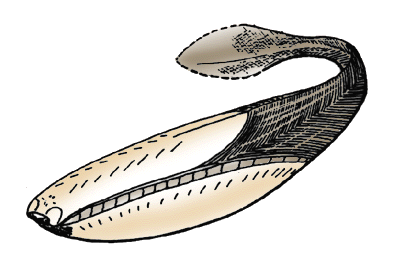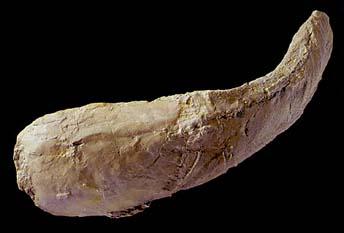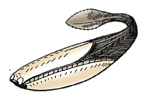Arandaspida
Philippe Janvier
- Arandaspis

- Porophoraspis

- Sacabambaspis

- Andinaspis

Introduction
The Arandaspida, or arandaspids, are a small group of armored, fossil jawless vertebrates, which lived in the Ordovician (from -480 to -440 million years ago). They are thus among the earliest known craniates, if one excepts the controversial Euconodonta. They are regarded as belonging to the Pteraspidomorphi, because of the large, median dorsal and ventral plates of their head armor. Arandaspids were marine and are recorded only from Australia and South America (Bolivia and Argentina).
Characteristics
Arandaspids are characterized by:
- Frontally placed eyes, included in an anterior notch of the dorsal shield.
- long, posteriorly slanting series of about twenty diamond-shaped platelets which separate the dorsal from the ventral shield of the head armor. Between these platelets open minute external gill openings.
The head armor of arandaspids is elongated, fusiform, with a rather flat dorsal shield, and a bulging ventral shield. The eyes, surrounded by a sclerotic ring, are housed in a notch at the anterior end of the dorsal shield. The nostrils are nor clearly located, but may have been situated between the eyes. Ventrally, the ventral lip of the mouth is armed with long series of small oral plates which recall those of heterostracans. In the anterior part of the dorsal shield are two, closely-set holes, which have been thought to be a paired pineal opening, but which are more likely the external openings of the endolymphatic ducts. The gill openings are probably numerous (more than 15) and minute. They opened between the diamond-shaped platelets which separate the dorsal from the ventral shield.
The body is covered with rod-shaped scales arranged in chevrons, and the tail is probably pad-shaped and diphycercal. The dermal bones of arandaspids consist of aspidine (acellular bone) and are ornamented with oakleaf-shaped tubercles which seem to contain no dentine. The sensory-lines were housed in narrow grooves between the tubercles.
Discussion of Phylogenetic Relationships
The Arandaspida comprise four monospecific genera, Arandaspis, Porophoraspis, Sacabambaspis, and Andinaspis, which occur in the Middle Ordovician of Australia, Bolivia, and Argentina, Sacabambaspis is the best known genus. Fragments of arandaspid bones are, however known from the base (Arenig; 480 million years) to the top (Ashgill; 440 million years) of the Ordovician. They are thus the earliest known undisputed craniate remains.
To date, there is no phylogeny of the Arandaspida and, considering the fragmentary state of the material of Porophoraspis and Andinaspis, the only available characteristics would be in the aspect of the dermal ornamentation. The tubercles of Arandaspis are drop-shaped and scalloped, those of Sacabambaspis and Andinaspis oakleaf-shaped, and those of Porophoraspis are perforated by large pores. Which of these types of ornamentation is primitive for the group is unknown, although one may note that the earliest known arandaspid fragments are of the Porophoraspis type.
References
Gagnier, P. Y. (1989). The oldest vertebrate: a 470-million-year-old jawless fish, Sacabambaspis janvieri, from the Ordovician of South America. National Geographic Research, 5, 250-253.
Gagnier, P. Y. (1993a). Sacabambaspis janvieri, Vertébré ordovicien de Bolivie. 1, Analyse morphologique. Annales de Paléontologie, 79, 19-69.
Gagnier, P. Y. (1993b). Sacabambaspis janvieri, Vertébré ordovicien de Bolivie. 2. Analyse phylogénétique. Annales de Paléontologie, 79, 119-166.
Ritchie, A., and Gilbert-Tomlinson, J. (1977). First Ordovician vertebrates from the southern hemisphere. Alcheringa, 1, 351-368.
Shergold, J. H. (1991). Late Proterozoic and Early Palaeozoic palaeontology and biostratigraphy of the Amadeus Basin. In Geological and Geophysical Studies in the Amadeus basin, Central Australia (ed. R. J. Korsch and J. M. Kennard). Bulletin of the Bureau of Mineral Resources, 236, 97-111.
Title Illustrations

| Scientific Name | Sacabambaspis |
|---|---|
| Location | Bolivia |
| Comments | The best known arandaspid, Sacabambaspis, from the Ordovician of Bolivia, shows the characteristic, frontally positioned eyes, like car head lamps. |
| Reference | after Janvier, P. (1996). Early Vertebrates. Oxford Monographs in Geology and Geophysics, 33, Oxford University Press, Oxford. |
| Image Use |
 This media file is licensed under the Creative Commons Attribution License - Version 3.0. This media file is licensed under the Creative Commons Attribution License - Version 3.0.
|
| Copyright |
© 1997

|
About This Page

Muséum National d'Histoire Naturelle Paris, France
Page copyright © 1997
 Page: Tree of Life
Arandaspida.
Authored by
Philippe Janvier.
The TEXT of this page is licensed under the
Creative Commons Attribution License - Version 3.0. Note that images and other media
featured on this page are each governed by their own license, and they may or may not be available
for reuse. Click on an image or a media link to access the media data window, which provides the
relevant licensing information. For the general terms and conditions of ToL material reuse and
redistribution, please see the Tree of Life Copyright
Policies.
Page: Tree of Life
Arandaspida.
Authored by
Philippe Janvier.
The TEXT of this page is licensed under the
Creative Commons Attribution License - Version 3.0. Note that images and other media
featured on this page are each governed by their own license, and they may or may not be available
for reuse. Click on an image or a media link to access the media data window, which provides the
relevant licensing information. For the general terms and conditions of ToL material reuse and
redistribution, please see the Tree of Life Copyright
Policies.
Citing this page:
Janvier, Philippe. 1997. Arandaspida. Version 01 January 1997 (under construction). http://tolweb.org/Arandaspida/16907/1997.01.01 in The Tree of Life Web Project, http://tolweb.org/









 Go to quick links
Go to quick search
Go to navigation for this section of the ToL site
Go to detailed links for the ToL site
Go to quick links
Go to quick search
Go to navigation for this section of the ToL site
Go to detailed links for the ToL site